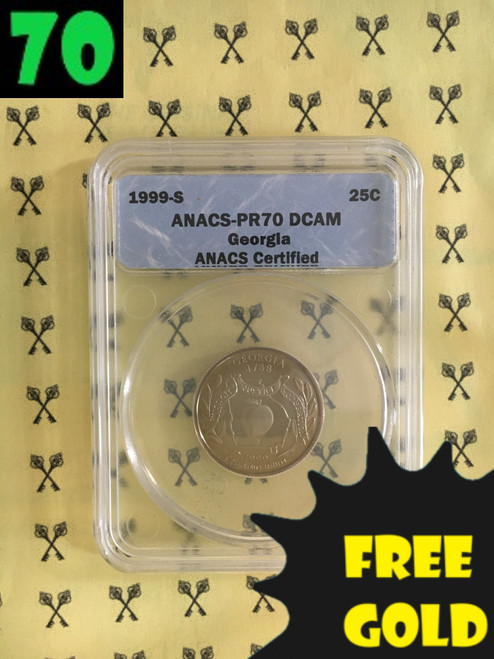-

-

1999-S Georgia State Quarter PERFECT ANACS PR70 Deep Cameo with FREE GOLDBACK*
MSRP: $70.00$16.91 -

-

Georgia
Will Georgia be the next state to get a Half Goldback?

Georgia Half (1/2) Goldback Concept. Click the image for all 0.5 Goldbacks for purchase.
Why Georgia Should Be the Next State to Get a Goldback Series
Georgia’s Golden Past Beckons Again
Georgia sparked America’s second gold rush in 1829, when the Georgia Gold Belt lit up Lumpkin County and beyond, drawing fortune-seekers to Dahlonega—aptly named from the Cherokee "tahlonega," meaning "yellow money." By 1838, the U.S. Mint opened a branch there, minting over $6 million in gold coins. The Goldback—a voluntary, spendable gold currency—revives this legacy, blending Georgia’s rich history with modern innovation. In a state where gold once fueled dreams, why not let it flow again as "yellow money" for the 21st century? Georgia’s past demands a golden encore.
Legislative Goldmine: A Path to Easy Transactions
Georgia’s legislature can make gold a cornerstone of commerce. Currently, gold and silver incur capital gains taxes under Georgia Code § 48-7-27, treating them as property, not currency. But change is afoot. In 2024, House Bill 1234 (HB 1234) proposed exempting precious metals from sales tax, stalling in committee but resurfacing in 2025 with broader scope. As of February 2025, HB 1234’s revised version—now including capital gains tax relief and legal tender status for gold—has passed the House Ways and Means Committee, awaiting full House approval. If enacted, this aligns with the U.S. Constitution’s nod to gold as money, slashing barriers to Goldback use.
Economic Resilience and Peach State Pride
The Goldback is Georgia’s ticket to economic strength and cultural swagger. Starting at 1/1000th of an ounce, it’s perfect for small buys—from Savannah’s shrimp boils to Athens’ indie shops. With inflation looming, its gold backing offers stability, echoing Georgia’s practical grit. Imagine a Georgia Goldback series featuring state icons: the Dahlonega Gold Mint, peaches, or the Okefenokee. These notes would double as collectibles, boosting tourism and local pride. Businesses adopting Goldbacks could attract sound-money fans, while dealers thrive under tax relief. This is Georgia’s chance to shine—economically and culturally.
Georgia-Specific Goldback Designs
Here’s how Georgia’s Goldback denominations could celebrate its significant people and places:
- 1 Goldback (1/1000 oz): Features the Dahlonega Gold Mint, its 1838 cornerstone gleaming, honoring Georgia’s gold rush epicenter and the first U.S. mint in the South.
- 5 Goldback (1/200 oz): Depicts Juliette Gordon Low in Savannah, founding the Girl Scouts in 1912, symbolizing Georgia’s trailblazing spirit.
- 10 Goldback (1/100 oz): Showcases the Okefenokee Swamp, its golden alligator eyes peering out, celebrating Georgia’s wild, primal beauty.
- 25 Goldback (1/40 oz): Highlights Martin Luther King Jr. at Ebenezer Baptist Church, capturing Georgia’s civil rights legacy and global impact.
- 50 Goldback (1/20 oz): Pictures Stone Mountain’s carved trio—Davis, Lee, and Jackson—set against a golden sunrise, nodding to Georgia’s complex history.
These designs weave Georgia’s story into a currency that’s as bold and enduring as the state itself.
A Golden Call to Lead the South
Utah and Nevada have Goldbacks, but Georgia can claim the South’s golden crown. With HB 1234 advancing, a gold rush heritage, and a flair for innovation, Georgia is primed to lead the region in sound money. Let’s urge the General Assembly to pass HB 1234 and launch a Georgia Goldback series. Picture gold in every hand—from Atlanta to Valdosta—proving Georgia’s not just the Peach State but the Gold State. The time is ripe to strike it rich again.
Rise up. Make Georgia golden.
History of Gold in Geogia
The story of gold in Georgia is both glittering and grim, rooted in natural bounty, human ambition, and historical tragedy. Georgia was home to the first major gold rush in the United States, decades before the famed California Gold Rush.
Discovery in Dahlonega (1828)
In 1828, Benjamin Parks was walking through the woods near what is now Dahlonega when he stumbled upon a yellow rock that turned out to be gold. His discovery triggered a flood of prospectors into the North Georgia mountains, giving rise to America's first gold rush. The area would soon be overrun with miners hoping to strike it rich.
The Georgia Gold Rush
By the early 1830s, thousands of miners—known as "Forty-Niners" of the South—were panning and digging throughout Lumpkin, White, and Hall counties. Makeshift towns and trading posts sprang up overnight. The region even warranted the construction of the Dahlonega Mint in 1838, where gold coins were struck until 1861.
The Cherokee Displacement
Tragically, the discovery of gold also accelerated the forced removal of the Cherokee people from their ancestral lands. The Trail of Tears, which began in part due to gold hunger, resulted in the suffering and deaths of thousands. The land that had once belonged to the Cherokee Nation was parceled off in a state-run land lottery.
Interesting Tale: The Lost Gold of the Confederacy
One of Georgia's enduring legends is the tale of the lost Confederate gold. As Union troops advanced in 1865, Confederate leaders reportedly moved a large cache of gold from the Dahlonega Mint southward. Somewhere along the way, the treasure vanished—possibly stolen or hidden. Treasure hunters still search for it to this day.
Modern Legacy
Today, Dahlonega celebrates its golden past with festivals, gold panning attractions, and museums. Though large-scale mining is long gone, traces of gold remain in the streams and soil of North Georgia—a legacy of both nature's generosity and a nation's growing pains.
“There’s gold in them thar hills,” a phrase often attributed to Georgia miner Matthew Stephenson, still echoes through the foothills as both history and legend.
Georgia State & ATB Coins for Sale with FREE GOLD
Celebrate Georia's statehood with a Perfect Proof 70 Deep Cameo quarter or remember the beauty of a Cumberland Island coin.